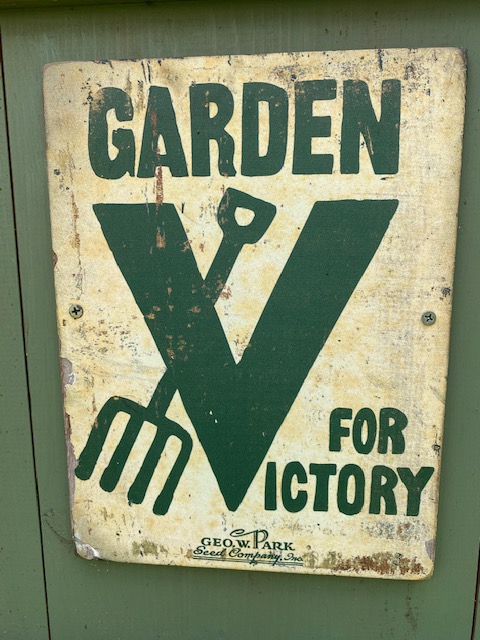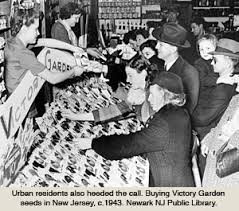A quick review of our soil tests from the 2020 spring season so far saw a greater than 10 percent increase in samples submitted for vegetable gardens. Perhaps it is just coincidental but this may also reflect a way many of us are dealing with these tough economic times due to the COVID-19 pandemic. For whatever reason, be assured that the UConn Soil Nutrient Analysis Lab remains open to accept your soil samples.
My grandparents (may they rest in peace) lived through the Great Depression years of 1929 into the 1930’s. When they came to this country as European immigrants they brought with them, among other items, basic food growing skills. Despite the relatively small lots in their Buffalo, NY backyards, they managed to grow a magnificent harvest of fruits and vegetables which were used fresh and preserved, and distributed among family and neighbors alike. I thought it might be interesting to review some other economically challenging times Americans have been faced with over the past century to see how local food gardening figured into coping with financial hardship.
As citizens left the agriculturally-based countryside and moved into urban areas, less food was grown by individual persons and instead they frequented the neighborhood grocery store for their fruits and vegetables and other staples. In times of good fortunes, their urban wages covered the cost of groceries. During economic downturns when unemployment became more widespread, many became impoverished and unable to buy enough food to feed their families. One such time in this country was during the 1890’s. It was during this period that ‘Pingree’s Potato Patches’ came into being.
Haze S. Pingree was the mayor of Detroit and requested that owners of vacant lots allow the unemployed to grow vegetables on their land. This saved the city money because less city aid was necessary to help the unemployed. It saved the taxpayers money because their taxes didn’t go up as high as they would have if they had to purchase food that wasn’t being produced locally. But the real benefit was to the unemployed who now had, at least temporarily, a feeling of self-respect and accomplishment, not to mention the fresh produce and opportunities for exercise and to socialize with other city residents.
Planting a ‘Liberty Garden’ was the patriotic thing to do during the First World War. Food production in Europe had dropped off precipitously because the farmers had left their fields to go to war and also, growing crops was not easy to do in war zones. It fell to the Americans to grow and supply food for the 120 million residents of the Allied countries. In 1917, the National War Garden Commission was founded by Charles Lathrop Park and there were more than 3 million garden plots by the end of that year. Americans were encouraged to plant gardens to feed ourselves and our allies, reduce fuel and transportations costs and share in this tremendous burden of war. Posters, cartoons, press releases and pamphlets served to educate gardeners on growing and preserving the harvest, and foster national interest in growing food.

Dig for Victory by artist Peter Fraser from Wikipedia.org
President Woodrow Wilson further encouraged the ranks of the food growing public saying, “Everyone who creates or cultivates a garden helps…..This is the time for America to correct her unpardonable fault of wastefulness and extravagance.” By 1918, there were over 5 million garden plots!
The 2009 economic crisis had many likening it to the Great Depression, which started in1929 and lasted well into the late 1930’s. Hundreds of thousands lost their jobs in America but it too had worldwide financial repercussions. Relief gardens, sometimes referred to as welfare gardens or subsistence gardens were set up with governmental assistance to provide food and work opportunities. The greater governmental involvement probably sprung from the fact that it wasn’t the individual who was responsible for this massive economic failing but rather the inadequacies of the system as a whole.

Recreated Victory Garden at Strawberry Banke. Photo by dmp, 2007
It took several years to set up the gardening programs during the Great Depression but by 1933, most were resolved. Also non-governmental organizations participated in the war to combat hunger. Those who owned their own plot of land were encouraged to use it for food production and leave the community garden spots for those less fortunate. Both seeds and gardening supplies were distributed to the gardeners. Some farmers criticized the program believing that it was contributing to overproduction.
With President Franklin D. Roosevelt’s ‘New Deal’ policy in 1933, over 3 billion dollars of aid was given to work garden programs being distributed by the Federal Emergency Relief Administration. Increased relief dollars, not surprising, came with stricter eligibility restrictions and not everyone in need was able to obtain assistance through these gardening programs. Finally, in 1935, funding was cut for these relief garden programs although some gardens, for example, those in New York City, continued to be cultivated. Working in the relief garden programs was no longer seen as an opportunity to improve one’s circumstances but simply as a food source for those less fortunate.

Recreated Victory Garden at Strawberry Banke, Photo by dmp, 2007
Just a few short years later, with the start of World War II, ‘Victory Gardens’ began sprouting up in response to the War Food Administration’s National Victory Garden Program. Some of these gardens were vestiges of WWI or depression era gardens but many were recent arrivals. Goals for these gardens included lessening the demands on commercial vegetable growers and processors so more food would be available to feed our troops, reducing food transportation needs to conserve energy for war efforts, increase self-sufficiency by preserving food for future needs, and to boost American morale by participating in healthy exercise and nutritious eating.

Victory garden sign, Photo by dmp,2020
Even Eleanor Roosevelt rallied to the cause having a Victory Garden installed on the grounds of the White House although apparently it was, at first, a source of distress to the USDA as they feared is would have a negative impact on the food industry. Nonetheless, the USDA did come round and ended up distributing information about food gardening in their public services booklets.
Efforts to cultivate Victory Gardens were enormously successful with 5.5 million gardeners participating in 1942. Seed companies had been remarking about the increase in vegetable seed sales this past year but it was nothing compared to over 300 percent increase they saw back then! Estimates by the USDA are that the Victory Gardens were producing 9 to 10 million pounds of produce which is about 44 percent of the fresh fruits and vegetables consumed at that time!
The war ended. Growing one’s own food was not high on the list of priorities as attention turned to rock and roll, teen idols like Elvis Presley, blue collar jobs, poodle skirts, drive ins, Betty Crocker casseroles and production of Baby Boomers.
While no governmental figure, that I am aware of, is encouraging growing one’s own food, the increased demand for seeds, fruit plants and chicks seems to indicate a real concern that food items may be limited as this pandemic eludes control. Folks with plant cultural or pest questions are welcome to contact the horticulturists at the UConn Home & Garden Education Center at ladybug@uconn.edu. We’re here to help you grow.
Stay safe.
Dawn P.

